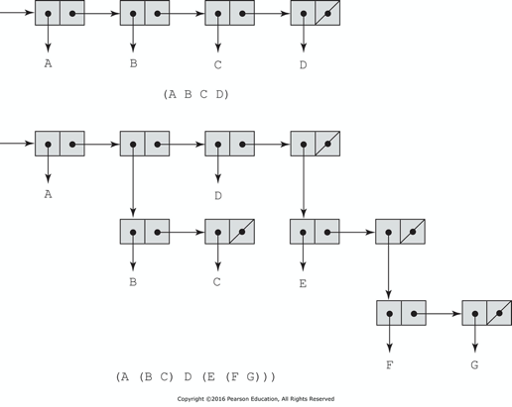27 - Functional#
List Functions#
QUOTEtakes one parameter and returns the parameter without evaluation.QUOTEis required because the Scheme interpreter, namedEVAL, always evaluates parameters to function applications before applying the function.QUOTEis used to avoid parameter evaluation when it is not appropriate.QUOTEcan be abbreviated with the apostraphe prefix operator:'(A B)is equivalent to(QUOTE (A B))
CAR,CDR, andCONS.
List representation and functions:

Examples:
(CAR '((A B) C D))returns(A B)(CAR 'A)is an error(CDR '((A B) C D))returns(C D)(CDR 'A)is an error(CDR '(A))returns()(CONS '() '(A B))returns(() A B)(CONS '(A B) '(C D))returns((A B) C D)(CONS 'A 'B)returns(A . B)(a dotted pair)
LIST is a function for building a list from any number of parameters.
(LIST 'apple 'orange 'grape)returns(apple orange grape)
Predicate Functions#
EQ? takes two expressions as parameters (usually two atoms); it returns #T if both parameters have the same pointer value; otherwise #F.
(EQ? 'A 'A)yields#T(EQ? 'A 'B)yields#F(EQ? 'A '(A B))yields#F(EQ? '(A B) '(A B))yields#For#T(EQ? 3.4 (+ 3 0.4))yields#For#T
EQV? is like EQ?, except that it works for both symbolic and numeric atoms; it is a value comparison, not a pointer comparison.
(EQV? 3 3)yields#T(EQV? 'A 3)yields#F(EQV? 3.4 (+ 3 0.4))yields#T(EQV? 3.0 3)yields#F(floats and integers are different)
LIST? takes one parameter; it returns #T if the parameter is a list; otherwise #F.
(LIST? '())yields#T
NULL? takes one parameter; it returns #T if the parameter is the empty list; otherwise #F
(NULL '(()))yields#F
member takes an atom and a simple list; returns #T if the atom is in the list; #F otherwise
(DEFINE (member atm a_list)
(COND
((NULL? a_list) #F)
((EQ? atm (CAR a_list)) #T)
(ELSE (member atm (CDR a_list)))
))
equalsimp takes two simple lists as parameters; returns #T if the two simple lists are equal; #F otherwise.
(DEFINE (equalsimp list1 list2)
(COND
((NULL? list1) (NULL? list2))
((NULL? list2) #F)
((EQ? (CAR list1) (CAR list2))
(equalsimp(CDR list1) (CDR list2)))
(ELSE #F)
))
equal takes two general lists as parameters; returns #T if the two lists are equal; #F otherwise.
(DEFINE (equal list1 list2)
(COND
((NOT (LIST? list1)) (EQ? list1 list2))
((NOT (LIST? list2)) #F)
((NULL? list1) (NULL? list2))
((NULL? list2) #F)
((equal (CAR list1) (CAR list2))
(equal (CDR list1) (CDR list2)))
(ELSE #F)
))
append takes two lists as parameters, returns the first parameter list with the elements of the second parameter list appended at the end.
(DEFINE (append list1 list2)
(COND
((NULL? list1) list2)
(ELSE (CONS (CAR list1)
(append (CDR list1) list2)))
))
LET is actually shorthand for a LAMBDA expression applied to a parameter.
(let ((<variable 1> <init 1> ...) <body>)is the same as:((lambda (<variable 1> .. ) <body>) <init 1> ...)(LET ((alpha 7)) (* 5 alpha))is the same as((LAMBDA (alpha) (* 5 alpha)) 7)
(DEFINE (quadratic_roots a b c)
(LET (
(root_part_over_2a
(/ (SQRT (- (* b b) (* 4 a c))) (* 2 a)))
(minus_b_over_2a (/ (- 0 b) (* 2 a))))
(LIST (+ minus_b_over_2a root_part_over_2a)
(- minus_b_over_2a root_part_over_2a))
))
Tail Recursion#
A function is tail recursive if its recursive call is the last operation in the function.
A tail recursive function can be automatically converted by a compiler to use iteration, making it faster.
Scheme language definition requires that Scheme language systems convert all tail recursive functions to use iteration.
Example of rewriting a function to make it tail recursive, using a helper function
Original:
(DEFINE (factorial n)
(IF (<= n 0)
1
(* n (factorial (- n 1)))
))
Tail recursive:
(DEFINE (facthelper n factpartial)
(IF (<= n 0)
factpartial
(facthelper (- n 1) (* n factpartial)))
)
(DEFINE (factorial n)
(facthelper n 1))
Functional Form#
Composition
If
his the composition offandg, h(x) = f(g(x))
(DEFINE (g x) (* 3 x))
(DEFINE (f x) (+ 2 x))
(DEFINE h x) (+ 2 (* 3 x)) "The composition"
In Scheme, the functional composition function
composecan be written:
(DEFINE (compose f g) (LAMBDA (x) (f (g x))))
((compose CAR CDR) '((a b) c d)) "yields c"
(DEFINE (third_a_list)
((compose CAR (compose CDR CDR)) a_list)) "is equivalent to CADDR"
Apply-to-All - one form in Scheme is map
Applies the given function to all elements of the given list
(DEFINE (map fun a_list)
(COND
((NULL? a_list) '())
(ELSE (CONS (fun (CAR a_list))
(map fun (CDR a_list))))
))
(map (LAMBDA (num) (* num num num)) '(3 4 2 6))yields(27 64 8 216)
Functions That Build Code#
It is possible in Scheme to define a function that builds Scheme code and requests its interpretation.
This is possible because the interpreter is a user-available function, EVAL.
Adding a List of Numbers#
(DEFINE (adder a_list)
(COND
((NULL? a_list) 0)
(ELSE (EVAL (CONS '+ a_list)
user-initial-environment))
))
The parameter is a list of numbers to be added’
adderinserts a+operator and evaluates the resulting list.Use
CONSto insert the atom+into the list of numbersBe sure that
+is quoted to prevent evaluationSubmit the new list to
EVALfor evaluation
